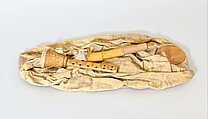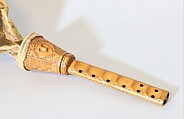Diple sa mješinom
Ante Delas Croatian
Not on view
The diple sa mješinom is a Croatian bagpipe found the Dalmatian region. Its distribution extends along the Adriatic coast from Istira in the North all the way to southern Bosnia and Herzegovina in the south. This instrument was played for celebratory events, such as annual festivals and weddings, and was considered a shepherd’s instrument. While musicians played for entertainment, their music was not considered as a source of income; they mainly played for free (Marković 1957:54) or for refreshments (Ceribašić 2011:5).
This instrument was made in 1935 by Ante Delaš, from Želovo, Dalmatia. Želovo was one of the main centres of diple-making in Dalmatia, along with Žegar and Otišić. These instruments are all very similar and only present slight organological differences. The melodic pipe is made out of a single piece of wood – usually maple, walnut or chestnut (Marković 1957:54) – within which two thin cylindrical bores were. The right bore has six holes, and the left hand bore has two holes, which are used to change the pitch of the drone. The cylindrical bores are each fitted with single reeds that are protected by the stock. The stock is intricately carved with geometrical patterns. In a central position we find a human head, one of the defining aesthetical characteristics of diples across the Dalmatian area (Širola 1937:24-25). The bag is made out of an animal; the melodic pipe emerges from the neck and the two forelegs are preserved. Historical examples show that the forelegs would have been tied around wild boar tusks of a three year-old sow (Širola 1937:141) or wooden plugs in the shape of tusks (Marković 1957:54). These are absent on this instrument and may have been lost over the course of the 20th century. The insufflation pipe is inserted into the center of the bag. The lower end of the hide is tied around a circular piece of wood, the ‘rotačka’. On this instrument, the rotačka is unadorned, but it is often carved with patterns similar to those found on the double melodic pipe.
This instrument was formerly owned by Božidar Širola (1889 - 1956). Širola was a specialist of Croatian music in the first half of the twentieth century. He was a composer, the curator and director of the Ethnographic Museum, the dean of the Music Academy of Zagreb, and a high school teacher (Brožek 1957). The instrument was part of the New York Public Library collection until 1976, when it was exchanged along with forty-two other instruments and six accompanying items for a collection of sheet music and music books held at the Metropolitan Museum.
(Cassandre Balosso-Bardin, 2023)
References
Brožek, Josef, 1957. Božidar Širola. Journal of the International Folk Music Council, 9, 77-77.
Ceribašić, Naila, 2011. ‘Pavo Gadanyi: A Profile of a Bagpiper, a Convivial Builder of Social Communication’. Studia instrumentorum musicae popularis II (New Series), ed. Gisa Jähnichen. Münster: Verlagshaus Monsenstein und Vannerdat OHG, 1-12
Marković, Zagroka, 1957. Narodni musićki instrumenti. Belgrade: Etnografski muzej
Širola, Božidar, 1937. Sviraljke sudarnim jezičkom. Zagreb: tisak nadbiskupske tiskare.
Due to rights restrictions, this image cannot be enlarged, viewed at full screen, or downloaded.
This artwork is meant to be viewed from right to left. Scroll left to view more.






